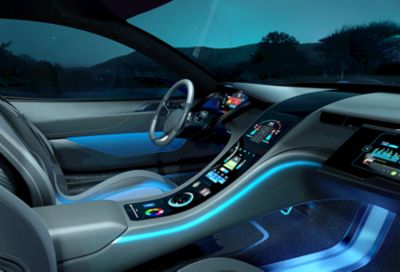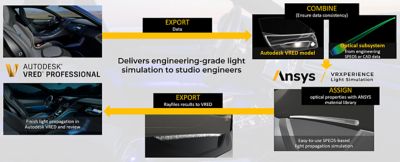-
Ansysは、シミュレーションエンジニアリングソフトウェアを学生に無償で提供することで、未来を拓く学生たちの助けとなることを目指しています。
-
Ansysは、シミュレーションエンジニアリングソフトウェアを学生に無償で提供することで、未来を拓く学生たちの助けとなることを目指しています。
-
Ansysは、シミュレーションエンジニアリングソフトウェアを学生に無償で提供することで、未来を拓く学生たちの助けとなることを目指しています。
ANSYS ADVANTAGE MAGAZINE
DATE: 2020
Collaboration Supports Innovation
By Ansys Advantage Staff
Ansys and Autodesk have joined forces to launch VRXPERIENCE Light Simulation, a new optical engineering solution that bridges a critical gap in customers’ product development workflows. This type of value-added collaboration is the key to unlocking the full potential of today’s advanced engineering technologies ― and taking customer ROI to a new level.
The digitalization of the business world ― and, in particular, the business of engineering ― has equipped companies with a range of advanced technologies that solve critical functional and performance-related problems. From computer-aided design to multiphysics simulation, digitalization has delivered a range of smart, automated tools that have truly revolutionized the product development process, generating a huge return on investment (ROI) for customers.
While the first wave of the digital revolution focused on acquiring and leveraging solutions across the product development team, the second wave focuses on maximizing that initial ROI via the tighter integration of those solutions.
“Individual processes have been optimized via tools such as simulation and virtual prototyping,” explains Eric Bantegnie, vice president of the systems and platform business unit at Ansys. “Now it’s time to drive increased value from those solutions by looking at the remaining sources of efficiencies. Increasingly, we’re finding those at the integration points ― the handoffs from one best-in-class tool to another.”
Increasing the integration efficiencies of tools requires a new approach based on collaboration. A case in point: Recently, Ansys partnered with Autodesk to address a key pain point for automotive lighting designers and engineers. The two companies have seamlessly integrated Autodesk VRED, a 3D visualization solution for studio designers, and Ansys VRXPERIENCE Light Simulation, a solution providing access to Ansys Speos physics-based lighting simulation, used by the optical engineers who bring automotive lighting design to life.
“In talking with customers, we realized that there was a lack of collaboration and communication between automotive lighting designers and optical engineers,” says Thomas Heermann, associate vice president, automotive and conceptual design, at Autodesk.
“Lighting designers would create these aesthetically beautiful concepts in Autodesk VRED,” continues Heermann. “Then they would hand them off for engineering and analysis in Speos, where the designs could be proven physically impractical, noncompliant or otherwise flawed. What followed was a lot of time-consuming, costly, iterative handoffs until the aesthetic vision could be balanced with physics-based, practical considerations.”
In the old workflow, significant corrections were often required at a relatively late stage to adjust lighting designs for safety and regulatory compliance, as well as cost-effective production and manufacturability. Weeks or even months of tedious, back-and-forth design updates and engineering analysis might be needed to satisfy both the original design intent and physical considerations.
Even worse, process gaps meant that a new car model could be released with a lighting defect that was overlooked ― resulting in a potential recall and significant damage to an automaker’s brand image and reputation.
“Since the majority of the world’s automotive lighting teams use both Ansys and Autodesk solutions, this was not an isolated problem,” Bantegnie points out. “Instead, it was a pressing challenge that both technology providers recognized in talking with our customers. We realized we needed to create a more efficient, seamless and accurate engineering process for automotive lighting teams.
Autodesk VRED 3D visualization software helps designers and engineers create product presentations, design reviews and virtual prototypes using interactive ray tracing and analytic render modes.
BALANCE LIGHTING FORM WITH FUNCTION
Autodesk and Ansys partnered to address this customer need and add value for their shared customers. The resulting solution, VRXPERIENCE Light Simulation, brings the powerful capabilities of Ansys optical simulation into the design studio for the first time. From their earliest lighting concepts, automotive designers can test the physical soundness and practicality of their ideas ― reducing design iterations to cut significant time and costs from the development cycle.
Equally important, the Ansys–Autodesk collaboration supports a new level of customer innovation, which is incredibly important in today’s global automotive industry.
“Lighting is increasingly an expression of both an automaker’s brand identity and its design aesthetic,” notes Heermann. “A number of studies have shown that lighting features ― such as the shape of a car’s headlights ― are a crucial part of the consumer’s purchasing decision. In the luxury market, ambient and dynamic interior lighting schemes are not an option today, but a requirement.”
“At the same time,” adds Bantegnie, “lighting has to provide the right level of illumination for safety and the right level of energy efficiency to meet regulatory standards. Our partnership is aimed at rapidly producing extreme lighting innovations that set our customers apart ― but are also achievable and high-performing. Our goal is to balance form with function, quickly and cost-effectively, so our customers can deliver innovative designs to the market before their competitors.”
By leveraging VRXPERIENCE Light Simulation, automakers can make digital design trade-offs at an early stage, before the cost of rework escalates. They can explore emerging developments in materials, as well as optics technologies such as light guides, optical fibers, black panels and illuminated fabric. They can test the manufacturability and sustainability of their designs. They can create customized lighting configurations in a fraction of the time involved in traditional, iterative processes, which is critical as large-scale product customization becomes a goal of every industry.
“The world’s automakers are facing incredibly complex challenges as they develop next-generation product systems such as autonomous and electric vehicles,” Bantegnie remarks. “Disruption is constant, whether that means emerging consumer needs, new materials, advanced manufacturing practices, or new regulations for safety or environmental impact. As technology providers and ecosystem partners, it’s incumbent on Ansys and Autodesk to identify new ways to add value and help address our automotive customers’ needs.”
By bringing together Ansys and Autodesk solutions in a single, unified workflow, VRXPERIENCE Light Simulation bridges the gap between design and engineering by delivering engineering-grade light simulation to studio designers.
A CHALLENGING, BUT NECESSARY, CULTURAL CHANGE
According to both Ansys and Autodesk, the technical challenges involved in integrating their solutions were fairly straightforward. Perhaps a bigger challenge was overcoming the cultural notion that the two companies should be competitors, not partners.
“When simulation and visualization were new concepts, it was easy to characterize our two businesses as rivals,” says Heermann. “But the reality is that we each produce highly specialized, best-in-class tools that occupy their own spaces in the product development process. To drive additional customer value, we need to complement each other’s capabilities and find common ground. We need to work together to identify and address the remaining inefficiencies in the end-to-end product development process.”
“Now that digitalization has delivered enormous benefits ― and a huge ROI ― via best-in-class solutions, the logical next step is to add new value by connecting those tools,” Bantegnie states. “To drive innovation, manage disruptions and accelerate responsiveness, the functional boundaries and process roadblocks need to be eliminated. The new level of collaboration we’re seeing between automotive lighting designers and optical engineers is a trend that needs to be encouraged across every industry and every product development team.”
Ansysができること
Ansysができること
お問い合わせ
お問い合わせいただき、ありがとうございます。
当社はお客様の質問にお答えし、お客様とお話できることを楽しみにしています。Ansysの営業担当が折り返しご連絡いたします。














